Themed collection Nanomaterial applications in water

Recent progresses in the modification strategies of MXene-based membranes for water and wastewater treatments
MXene, a type of two-dimensional material, has garnered significant interest as a promising next-generation membrane material. This work elucidates the modification strategies employed by MXene-based membranes and evaluates their performances.

Environ. Sci.: Nano, 2025,12, 150-188
https://doi.org/10.1039/D4EN00712C
Recent trends on MIL-Fe metal–organic frameworks: synthesis approaches, structural insights, and applications in organic pollutant adsorption and photocatalytic degradation
Metal–organic frameworks (MOFs) are gaining considerable interest for various uses ranging from adsorption, photocatalysis, electrocatalysis, chemical sensing, catalysis and gas separation.

Environ. Sci.: Nano, 2023,10, 2957-2988
https://doi.org/10.1039/D3EN00332A
Degradation of organic contaminants by peroxymonosulfate activated with zeolitic imidazolate framework-based catalysts: performances, mechanisms and stability
ZIF-based catalysts have great potential for PMS activation in environmental treatment. State of the art and prospects in recent breakthroughs are presented in this review.
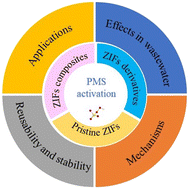
Environ. Sci.: Nano, 2023,10, 1528-1552
https://doi.org/10.1039/D3EN00007A
Carbon nanomaterial-based membranes for water and wastewater treatment under electrochemical assistance
Carbon nanomaterial-based membranes exhibit fascinating permselectivity for water and wastewater treatment, and their performance could be further improved under electrochemical assistance, benefiting from their good electrical conductivity.
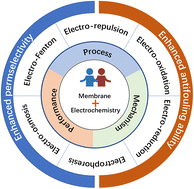
Environ. Sci.: Nano, 2023,10, 11-40
https://doi.org/10.1039/D2EN00545J
Advances and challenges of broadband solar absorbers for efficient solar steam generation
This review provides guidance for solar absorber design, selection, and optimization, and evaporation system engineering for efficient solar-driven evaporation.
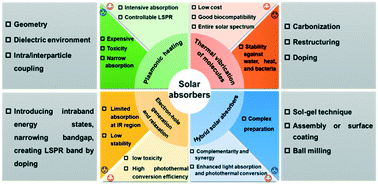
Environ. Sci.: Nano, 2022,9, 2264-2296
https://doi.org/10.1039/D2EN00070A
Development of a novel MOF-based nanofiber for highly selective removal of cobalt from aqueous solutions
This study addresses the challenge of cobalt ion separation by developing novel MOF nanofibers, Co(II)-PIIMs.

Environ. Sci.: Nano, 2025,12, 2320-2330
https://doi.org/10.1039/D4EN01058B
Coating complex metallic surfaces with passivated silver nanoparticles for long-term biofilm control
Passivation increases the coating's stability and reduces the release of silver ions without compromising biofouling resistance.

Environ. Sci.: Nano, 2025,12, 1872-1880
https://doi.org/10.1039/D4EN00797B
A portable and reusable sensor system based on graphene for real-time and sensitive detection of lead ions in water
A portable and wireless sensor system based on graphene for fast and sensitive detection of lead ions in water.

Environ. Sci.: Nano, 2025,12, 1840-1848
https://doi.org/10.1039/D4EN00884G
Efficient bimetallic metal–organic framework derived magnetic Co/N-PC-800 nanoreactor for peroxymonosulfate activation and carbamazepine degradation
Co/N-PC-T (600, 700, 800, 900) were successfully obtained by calcining the precursor Co@Zn-MOF, and Co/N-PC-800 exhibited excellent peroxymonosulfate activation for CBZ, achieving 98% degradation within 30 minutes.

Environ. Sci.: Nano, 2025,12, 1609-1625
https://doi.org/10.1039/D4EN00898G
Colorimetric visualization detection of perfluorooctanoic acid based on host–guest interactions with cyclodextrin-modified gold nanoparticles
Our colorimetric sensor developed with cyclodextrin-modified gold nanoparticles provides a nano-sensor for the visual detection of PFOA with simplicity, rapid detection, and cost-efficiency.

Environ. Sci.: Nano, 2025,12, 1581-1591
https://doi.org/10.1039/D4EN01096E
Polymer–iron oxide nanofiber composites for lead removal: performance improvements through organic acid stabilization of nanoparticles to promote surface segregation during electrospinning
Polymer–iron oxide nanofiber composites.

Environ. Sci.: Nano, 2025,12, 1487-1500
https://doi.org/10.1039/D4EN00902A
A novel route to synthesize Bi/β-Bi2O3@carbon: mechanism and performance for efficient degradation of organic pollutants
Synergistic effects of components in Bi/β-Bi2O3@carbon enhance the activity. Electron-deficient species attack FWA351, resulting in breaking of C![[double bond, length as m-dash]](https://www.rsc.org/images/entities/char_e001.gif) C bonds and opening of aromatic rings, ultimately mineralizing into CO2, H2O and inorganic salts.
C bonds and opening of aromatic rings, ultimately mineralizing into CO2, H2O and inorganic salts.

Environ. Sci.: Nano, 2025,12, 1501-1514
https://doi.org/10.1039/D4EN00973H
Insights in photocatalytic/Fenton-based degradation of microplastics using iron-modified titanium dioxide aerogel powders
Degradation of microplastics (MPs) through the photocatalytic and photo-Fenton process using Fe-modified TiO2 aerogel powders.

Environ. Sci.: Nano, 2025,12, 1515-1530
https://doi.org/10.1039/D4EN00818A
Enhanced peroxymonosulfate activation by copper-doped bismuth oxides for the efficient photo-degradation of ciprofloxacin: crucial role of copper sites, theoretical calculation and mechanism insight
Cu doping enhances charge separation in BiO2−x nanosheets, activating PMS for efficient ciprofloxacin degradation under light irradiation.

Environ. Sci.: Nano, 2025,12, 1545-1557
https://doi.org/10.1039/D4EN00994K
Efficient, simultaneous, quantitative and qualitative detection of multiple phenols using highly water-stable Co2+-doped Cu–BTC as an electrocatalyst
A rational design of water-stable and high-efficiency MOF-based electrocatalysts for achieving durable sensitive electrochemical sensors for pollution detection remains a great challenge.

Environ. Sci.: Nano, 2025,12, 1570-1580
https://doi.org/10.1039/D4EN00912F
A novel Ce-doped hydrotalcite for the efficient removal of tetracycline hydrochloride in the photo-Fenton system: from properties to mechanisms
A Ce-doped hydrotalcite was synthesized, which completely removed tetracycline hydrochloride in the photo-Fenton system within 60 min.

Environ. Sci.: Nano, 2025,12, 1384-1400
https://doi.org/10.1039/D4EN00865K
Complete degradation of 2,4-dichlorophenol in a sequential sulfidated nanoscale zero-valent iron/peroxydisulfate system: dechlorination, mineralization and mechanism
The sequential S-nZVI/PDS process is a very promising and efficient approach for the complete mineralization of 2,4-DCP.

Environ. Sci.: Nano, 2025,12, 1414-1430
https://doi.org/10.1039/D4EN00737A
Optimization of Fenton-like reaction pathways using Ov-containing ZnO@nitrogen-rich porous carbon: the electron transfer and 1O2 triggered non-radical process
There is not much research on how to control the PDS reaction pathway. This work reports that Ov-containing ZnO@nitrogen-rich porous carbon composites activate PDS to remove SMZ only through 1O2 and electron transfer.

Environ. Sci.: Nano, 2025,12, 936-947
https://doi.org/10.1039/D4EN00749B
Highly selective capture of palladium from acidic solution by sulfur-functionalized porous carbon microspheres: performance and mechanism
The sulfur-functionalized porous carbon microspheres provide a feasible and low-cost strategy for the selective recovery of Pd from highly acidic wastewater.

Environ. Sci.: Nano, 2025,12, 924-935
https://doi.org/10.1039/D4EN00738G
Interfacial behavior of ceria grown on graphene oxide and its use for hydrolytic and photocatalytic decomposition of bisphenols A, S, and F
CeO2/graphene oxide nanocomposites efficiently degrade bisphenols A, S, and F. Hydrolytic cleavage of bisphenol S was observed even without any illumination.

Environ. Sci.: Nano, 2025,12, 502-513
https://doi.org/10.1039/D4EN00787E
2D Mo2AlB2 transition-metal-aluminum-boride-phase-integrated TiO2 nanoparticles enable accelerated carbendazim photodegradation: impact of ohmic junctions and electric fields
An ohmic junction was developed by incorporating TiO2 nanoparticles into 2D Mo2AlB2 using ultrasound-assisted self-assembly. This novel composite showed enhanced photocatalytic degradation of carbendazim, accelerating pesticide breakdown.

Environ. Sci.: Nano, 2025,12, 729-747
https://doi.org/10.1039/D4EN00727A
Tuning La–O adsorption sites dispersion via hydrogen bond-capping organic–inorganic copolymerization strategy for enhanced phosphate removal
The developed LaCCH exhibited an enhanced capacity of 308.2 mgP gLa−1, revealing a strong correlation between the organic–inorganic interaction energy of La oligomers and hydrogel carriers, and the phosphate adsorption capacity.

Environ. Sci.: Nano, 2025,12, 716-728
https://doi.org/10.1039/D4EN00791C
Synthesis of two-dimensional bismuth molybdenum oxide (2D-BMO) nanosheets and their application as fluorescent probes for the detection of explosive nitroaromatic compounds
2D-BMO fluorescent nanosheets were synthesized using a solvothermal method followed by probe sonication.

Environ. Sci.: Nano, 2025,12, 597-607
https://doi.org/10.1039/D4EN00517A
Ternary 3D/2D/3D direct dual Z-scheme MOF-on-MOF-derived α-Fe2O3/g-C3N4/Fe-MOF photocatalyst for boosted sunlight-driven removal of metronidazole: effect of coexisting ions, mechanistic insights, and water matrices
Fabrication of cauliflower-like Fe(III) carboxylate MOF-based catalyst for degradation of MTZ via ROS generation in a solar-light-activated photocatalytic system and testing its efficacy under various water parameters and environmental substrates.

Environ. Sci.: Nano, 2024,11, 4805-4829
https://doi.org/10.1039/D4EN00610K
Hollow Co3O4 nanospheres modified with RuCl3 as peroxidase mimics for sensitive determination of sulfide ions at neutral pH
RuCl3-modified hollow Co3O4 nanospheres (Ru3+-C@Co3O4 HNSs) were utilized to establish a colorimetric sensor for selective determination of S2− ions.

Environ. Sci.: Nano, 2024,11, 4779-4787
https://doi.org/10.1039/D4EN00569D
Nanostructured copper electrodes – a new step in the development of microbial bioelectrochemical systems
A simple-to-manufacture and inexpensive biosensor based on a nanostructured copper electrode, mediators and immobilized yeast or bacteria is proposed for determining the biochemical oxygen demand in wastewater.

Environ. Sci.: Nano, 2024,11, 4562-4576
https://doi.org/10.1039/D4EN00440J
Role of water in vapor permeation through graphene oxide membranes
This study demonstrates that GO membranes enable efficient separation of aqueous and alcoholic vapor mixtures and discusses the critical vapor-permeation mechanism.

Environ. Sci.: Nano, 2024,11, 4513-4520
https://doi.org/10.1039/D4EN00462K
A novel electrochemical sensor for simultaneous determination of 2,4-dichlorophenol and 3-chlorophenol
A CeNiCu-LDH@CC electrochemical sensor for efficient detection of 2,4-dichlorophenol and 3-chlorophenol.

Environ. Sci.: Nano, 2024,11, 4348-4358
https://doi.org/10.1039/D4EN00588K
The performance and mechanism of phosphotungstic acid-modified NiFe-LDH heterogeneous photo-Fenton catalyst for efficient degradation of tetracycline
Mechanism diagram of TC-HCl degradation in the PTA-LDHs/H2O2/vis system.

Environ. Sci.: Nano, 2024,11, 4321-4336
https://doi.org/10.1039/D4EN00476K
Degradation of organic pollutants using a ternary heterojunction catalyst (CoS2/CoCo2O4–MnFe2O4) for activating peroxymonosulfate with magnetic separation, anti-ion interference, and low ion leaching
Activating persulfate to generate reactive oxygen species (ROS) for the effective degradation of toxic organic compounds is an important research topic in environmental management.

Environ. Sci.: Nano, 2024,11, 4211-4229
https://doi.org/10.1039/D4EN00475B
Ce/W-MIL-88B(Fe) photo-Fenton material achieving synchronous arsenate uptake and nitrite resourcing: unexpected role of arsenate in boosting photo-Fenton activity
Here, a novel MOF-based photo-Fenton material (Ce/W-MIL-88B(Fe)) was fabricated, which achieved synchronous arsenate (As(V)) uptake and nitrite (NO2−) resourcing.

Environ. Sci.: Nano, 2024,11, 4266-4278
https://doi.org/10.1039/D4EN00389F
Catalytic activity of Cu–cysteine coated on Ti3C2MXene toward peroxymonosulfate activation for carbamazepine degradation
Cu–cy/Ti3C2MXene demonstrated outstanding catalytic performance in activating peroxymonosulfate, leading to the production of reactive oxygen species that decomposed up to 98.6% of carbamazepine.

Environ. Sci.: Nano, 2024,11, 4174-4185
https://doi.org/10.1039/D4EN00342J
Revealing the importance of non-radical mechanisms in the degradation of sulfamethazine by Lewis acid-etched Co@MXene-activated peroxyacetic acid
Co@MXene activation of peracetic acid and degradation of sulfamethazine via two major pathways: non-radical activation and organic radical activation.

Environ. Sci.: Nano, 2024,11, 3918-3930
https://doi.org/10.1039/D4EN00453A
A metal-free photocatalytically active hybrid fiber as a novel self-cleaning adsorbent for enhanced tetracycline removal
A recyclable metal-free photocatalytically active hybrid fiber is fabricated, and presents a significantly photo-enhanced removal effect on tetracycline.

Environ. Sci.: Nano, 2024,11, 3856-3870
https://doi.org/10.1039/D4EN00387J
Synergistic bimetallic MOF-integrated MXene nanosheets for enhanced catalytic degradation of carbamazepine and hydrogen production: a dual-function approach for water remediation and energy applications
The MIL-100@ZIF-67@MXene composite was synthesized for the enhanced degradation of carbamazepine (CBZ) and activation of peroxymonosulfate (PMS).

Environ. Sci.: Nano, 2024,11, 3871-3886
https://doi.org/10.1039/D4EN00324A
The performance and mechanism of persulfate activated by CuFe-LDHs for ofloxacin degradation in water
Cu–Fe bimetallic synergy plays an important role in the generation of SO4·−.

Environ. Sci.: Nano, 2024,11, 3563-3573
https://doi.org/10.1039/D4EN00370E
Scalable and eco-friendly fabrication of anti-oil-fouling solar interfacial evaporator for efficient water purification
A simple room temperature fabrication methodology was reported in this work to prepare an interfacial solar evaporator for achieving stable water evaporation performance, with excellent anti-oil fouling capability.

Environ. Sci.: Nano, 2024,11, 3430-3439
https://doi.org/10.1039/D4EN00346B
Efficient photocatalytic degradation of ofloxacin by a polyimide/phosphate-doped porous coralline carbon nitride S-scheme heterojunction
The establishment of a heterojunction holds significant promise for facilitating the separation and migration of photogenerated carriers, thereby engendering robust photooxidation–reduction capabilities.

Environ. Sci.: Nano, 2024,11, 2978-2993
https://doi.org/10.1039/D4EN00277F
2D-rGO-supported FePc bifunctional nanozyme with enhanced catalytic activity for thiosulfate detection and rhodamine B degradation
FePc supported on 2D rGO has the enhanced catalytic activity. The prepared FePc@rGO nanocomposites not only can catalyze the oxidation of colorimetric substrates, but also can degrade RhB with the help of PMS.

Environ. Sci.: Nano, 2024,11, 3104-3113
https://doi.org/10.1039/D4EN00119B
Highly selective capture and efficient concentration of trace titanium dioxide nanoparticles in environmental waters by phosphorylated ferroferric oxide
Selectively and efficiently capturing trace titanium dioxide nanoparticles (TiO2NPs) in environmental waters is a prerequisite for their determination to understand their occurrence, behavior and effects in the environment.

Environ. Sci.: Nano, 2024,11, 2541-2549
https://doi.org/10.1039/D4EN00095A
Combined effect of Cu0 and oxygen vacancies in Cu-based zeolites enables highly efficient photo-Fenton-like performance for water purification
A novel environment-friendly oxygen-vacancy-rich Cu-doped zeolite decorated with Cu0 (Cu0@CuZ) was fabricated to achieve the high-efficiency removal of refractory organic pollutants in a photo-Fenton-like reaction.

Environ. Sci.: Nano, 2024,11, 2481-2493
https://doi.org/10.1039/D4EN00181H
Crystallinity regulation-induced organic degradation on ultra-thin 2D Co3O4/SiO2 nanosheets: the critical trigger of oxygen vacancies
The crystallinity of ultrathin Co3O4 nanosheet was tuned by adjusting the calcination atmosphere. The enriched oxygen vacancies, PMS-binding affinity and rapid Co2+/Co3+ conversion triggered both radical and nonradical reactions for SMX oxidation.

Environ. Sci.: Nano, 2024,11, 2507-2520
https://doi.org/10.1039/D4EN00134F
Highly radiation-resistant Al-MOF selected based on the radiation stability rules of metal–organic frameworks with ultra-high thorium ion adsorption capacity
Al-MOF synthesized based on MOF irradiation stability rules exhibits high stability against β-irradiation and ultra-high thorium adsorption capacity, which proves its huge potential application value in the field of radionuclide adsorption.
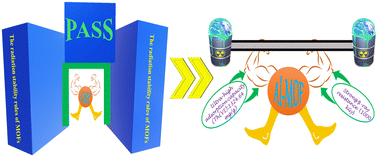
Environ. Sci.: Nano, 2024,11, 2103-2111
https://doi.org/10.1039/D4EN00076E
In situ biomimetic mineralization of a paper microfluidic device as a luminescent sensor for nitrite determination
Nucleation and growth of terbium-doped amorphous calcium phosphate (Tb-ACP) on cellulose fibers of a microfluidic paper-based analytical device (μPAD) towards an environmentally friendly design of a sensor for water pollutant.

Environ. Sci.: Nano, 2024,11, 1060-1069
https://doi.org/10.1039/D3EN00586K
Do potential dependent kinetics play a role in photocatalytic rate trends?
Higher order trends in the photocatalytic activity of semiconductors, concerning environmental remediation and energy applications, under increasing light illumination may originate in part or in whole from potential dependent kinetics.

Environ. Sci.: Nano, 2024,11, 645-656
https://doi.org/10.1039/D3EN00436H
S-doping Fe–Ce composites derived from PBA to accelerate Fe(III)/Fe(II) cycle in the Fenton-like process
S doping promoted the conversion of Fe(III) to Fe(II), which greatly improved the performance of the Fenton-like reaction.

Environ. Sci.: Nano, 2024,11, 103-112
https://doi.org/10.1039/D3EN00788J
Core–shell Ag@polypyrrole for synchronous pre-enrichment and immobilization of iodine (I−, IO3−) from liquid radioactive wastes
A core–shell silver-encapsulated polypyrrole, Ag@PPy, was prepared via in situ synthesis for simultaneous efficient adsorption and immobilization of iodide and iodate.
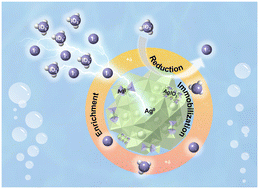
Environ. Sci.: Nano, 2024,11, 149-160
https://doi.org/10.1039/D3EN00675A
A cross-reactive plasmonic sensing array for drinking water assessment
The continuous monitoring of remote drinking water purification systems is a global challenge with direct consequences for human and environmental health. Nanoplasmonic sensors can monitor treatment systems and warn of failures.

Environ. Sci.: Nano, 2023,10, 3500-3508
https://doi.org/10.1039/D3EN00565H
Metal-free amorphous carbon nitride with N-vacancies for efficient photocatalytic decontamination: a case of peroxydisulfate-based nonradical oxidation mechanism
The elaborate design of the peroxydisulfate-based nonradical oxidation process. Nitrogen vacancies enhanced the surface affinity between the catalyst and PDS, and thus, the formation of the key complex (i.e., ACN–PDS*).
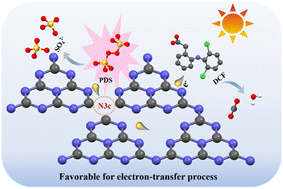
Environ. Sci.: Nano, 2023,10, 3450-3461
https://doi.org/10.1039/D3EN00614J
Robust degradation of tetracycline antibiotic through recyclable Fe3S4/Ti3C2MXene composites
Fe3S4/Ti3C2MXene shows over 90% TC degradation via Fenton activity, driven by the generation of reactive oxygen species. It exhibits remarkable reusability and stability over multiple cycles, promising sustainable TC removal from wastewater.

Environ. Sci.: Nano, 2023,10, 3401-3413
https://doi.org/10.1039/D3EN00560G
Real roles of FeOCl nanosheets in Fenton process
Most researchers believe that the high catalytic activity of FeOCl originates from its unique structure. In this study, we show that dissolved iron contributes significantly to the catalytic activity of FeOCl in the Fenton and photo-Fenton processes.
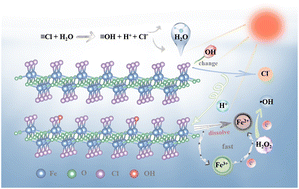
Environ. Sci.: Nano, 2023,10, 3414-3422
https://doi.org/10.1039/D3EN00643C
Carbonized polyacrylonitrile array as a sensitive, biocompatible, and durable substrate for surface-enhanced Raman spectroscopy
A carbonized PAN array was designed and applied as an effective SERS substrate. It provided a significant signal enhancement (∼105) with its strong broadband charge-transfer resonance and high reproducibility and consistency in the SERS spectrum.

Environ. Sci.: Nano, 2023,10, 3271-3280
https://doi.org/10.1039/D3EN00404J
Porous calcium copper titanate electrodes for paracetamol degradation by electro-oxidation via CuO-induced peroxymonosulfate activation
Pharmaceutical-induced water pollution threatens health and ecosystems. Advanced oxidation, like electrocatalysis with peroxymonosulfate and calcium copper titanate as a key catalyst, shows promise for removing trace pollutants.
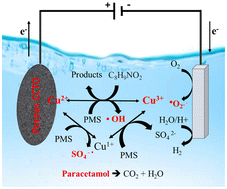
Environ. Sci.: Nano, 2023,10, 3156-3170
https://doi.org/10.1039/D3EN00317E
Structure and energetics of hydrogen bonding networks in dilute HOD/H2O solutions confined in silica nanopores
Nanoconfinement in silica nanopores strengthens hydrogen bonds near surfaces, and weakens hydrogen bonds in nanopore volume away from the surfaces.
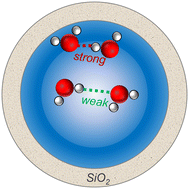
Environ. Sci.: Nano, 2023,10, 3025-3038
https://doi.org/10.1039/D3EN00291H
Efficient removal of viscous crude oil by a super-hydrophobic polystyrene/carbon black foam with photo-thermal conversion
In this study, carbon black nanoparticles were introduced in one-step to develop a super-hydrophobic polystyrene foam with efficient photo-thermal conversion and adsorption for highly viscous crude oil.
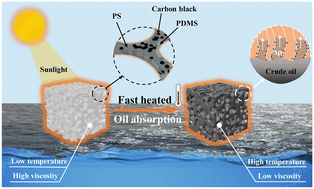
Environ. Sci.: Nano, 2023,10, 2913-2924
https://doi.org/10.1039/D3EN00439B
Porous silica nanospheres: a nanoplatform towards protein immobilization and cogent design of biosensors for aromatic water pollutant detection
A rational approach for exploiting the physicochemical properties of porous silica nanospheres (pSN) affecting biomolecule immobilization and aromatic water pollutant monitoring has been demonstrated.
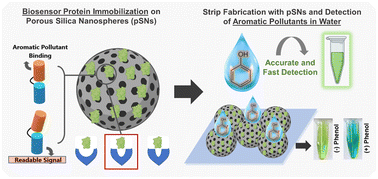
Environ. Sci.: Nano, 2023,10, 2799-2809
https://doi.org/10.1039/D3EN00217A
Microwave synthesis of Fe–Cu diatomic active center MOF: synergistic cyclic catalysis of persulfate for degrading norfloxacin
A heterostructured diatomic catalyst synthesized by a microwave hydrothermal method accelerates interfacial charge transfer and enhances the ability to treat antibiotic wastewater.
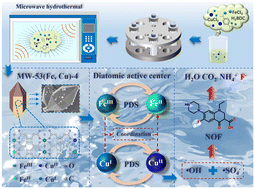
Environ. Sci.: Nano, 2023,10, 2778-2789
https://doi.org/10.1039/D3EN00340J
In situ synthesis of gold nanoclusters in hydrogels for the capillary based portable fluorescence analysis of hypochlorite in environmental samples
The incubation of agarose hydrogels embedded with BSA and chloroauric acid in alkali solutions facilitates the in situ growth of gold nanoclusters in capillary microcontainers, enabling the portable detection of ClO− with fluorescent responses.

Environ. Sci.: Nano, 2023,10, 2880-2889
https://doi.org/10.1039/D3EN00247K
The properties and efficacy of S-nZVI as a remediation agent in response to its preparation process and reaction conditions: a truth from meta-analysis
The influence of the preparation process (sulfurization method, sulfur reagents, and S/Fe molar ratio) and the decontamination conditions (initial pH value, and temperature) on the decontamination effect was quantitatively evaluated by meta-analysis.

Environ. Sci.: Nano, 2023,10, 2720-2732
https://doi.org/10.1039/D3EN00431G
Self-assembled peptide nanosheets functionalized with Fe3O4 nanoparticles with enhanced nanozymatic activity for sensitive colorimetric detection and selective adsorption of Hg2+
The combination of peptide nanosheets and magnetic Fe3O4 nanozymes promotes colorimetric detection and selective adsorption of Hg2+.

Environ. Sci.: Nano, 2023,10, 2767-2777
https://doi.org/10.1039/D3EN00395G
Mechanism of catalytic ozonation in different surface acid sites of oxide aqueous suspensions
Proposed mechanism of catalytic ozonation in different surface acid sites of oxide aqueous suspensions.

Environ. Sci.: Nano, 2023,10, 2312-2323
https://doi.org/10.1039/D3EN00331K
Selective tandem electroreduction of nitrate to nitrogen via copper–cobalt based bimetallic hollow nanobox catalysts
The hollow Cu–Co HNB catalyst selectively reduces NO3− to N2 by tandem catalysis in a chlorine-free system.

Environ. Sci.: Nano, 2023,10, 2332-2342
https://doi.org/10.1039/D3EN00403A
Hierarchical structured Cu@carbon/carbon cloth film with high levels of light absorption for efficient solar thermal desalination
A novel hierarchical structured Cu@carbon/carbon cloth film is developed for highly-efficient interfacial solar steam generation.
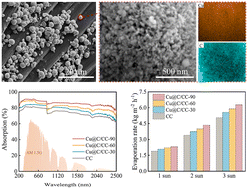
Environ. Sci.: Nano, 2023,10, 2324-2331
https://doi.org/10.1039/D3EN00252G
Achieving efficient uranium extraction by in situ ultrasonic texturization of commercial Fe powder
The in situ ultrasonic texturization of commercial Fe powder was employed to replace the n-ZVI for U(VI) extraction in fluoride (F−)-containing wastewater.

Environ. Sci.: Nano, 2023,10, 2201-2210
https://doi.org/10.1039/D3EN00269A
Effective heterogeneous Fenton-like degradation of antibiotics by ferroferric oxide nanoparticle coated reduced iron powder with accelerated Fe(II)/Fe(III) redox cycling
In this study, we present a novel strategy of accelerating cycle of Fe(II)/Fe(III) in iron-mediated catalyst for heterogeneous Fenton-like processes.
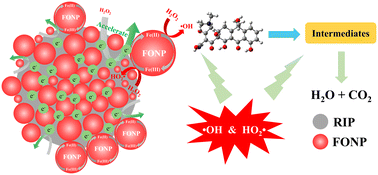
Environ. Sci.: Nano, 2023,10, 2066-2076
https://doi.org/10.1039/D3EN00272A
Structural design, biomimetic synthesis, and environmental sustainability of graphene-supported g-C3N4/TiO2 hetero-aerogels
Graphene-supported C3N4/TiO2 hetero-aerogels with high photocatalytic properties and sustainability are designed and synthesized.
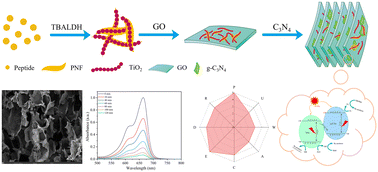
Environ. Sci.: Nano, 2023,10, 1257-1267
https://doi.org/10.1039/D3EN00077J
Efficient degradation of organic contaminants via a novel iron-based poly(ionic liquid)/polydopamine composite as the heterogeneous Fenton catalyst
Iron-based poly(ionic liquid)/polydopamine composite shows excellent degradation performance for organic pollutants, providing a promising route for the design of efficient and stable heterogeneous Fenton catalysts.
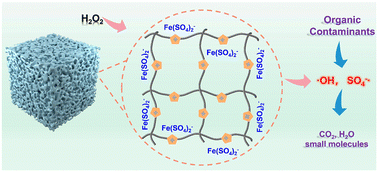
Environ. Sci.: Nano, 2023,10, 1232-1243
https://doi.org/10.1039/D3EN00001J
An innovative S-scheme PhC2Cu/Ag/Ag2MoO4 photocatalyst for efficient degradation of sulfamethazine antibiotics: heterojunctions and innergenerated-H2O2 promote radical production
Schematic diagram of the photocatalytic reduction mechanism for the PAM40 system.
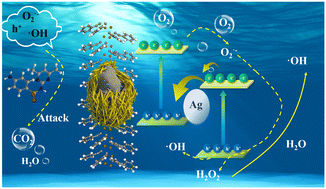
Environ. Sci.: Nano, 2023,10, 1053-1064
https://doi.org/10.1039/D3EN00056G
Leaf vein-biomimetic nanofibrous membrane with self-assembled nanonet for surface filtration of water contaminants
A leaf vein-biomimetic nanofibrous membrane was constructed by nonsolvent-induced phase inversion for high-performance surface filtration of water contaminants.
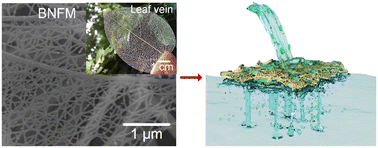
Environ. Sci.: Nano, 2023,10, 1030-1039
https://doi.org/10.1039/D2EN01078J
In situ growth of metal–organic frameworks in nanochannels for highly sensitive microcystin-LR detection
Harmful algal blooms lead to cyanobacteria toxins increase in natural water. A novel nanochannel-based sensing system utilizing metal–organic frameworks and DNA aptamers was developed for highly sensitive detecting microcystin-LR in real water.
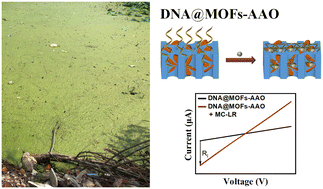
Environ. Sci.: Nano, 2023,10, 834-842
https://doi.org/10.1039/D2EN01119K
About this collection
This web collection features research articles published in Environmental Science: Nano focussed on nanomaterial applications in water.